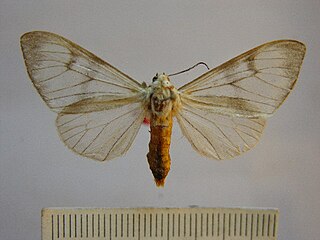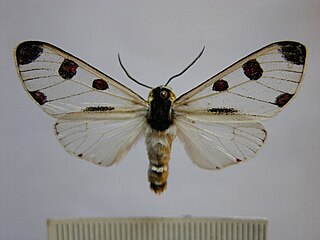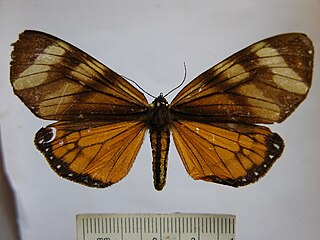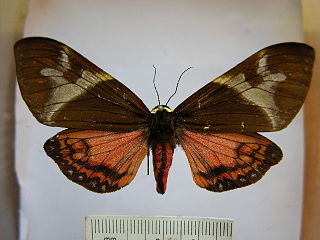Related Research Articles

Pseudophaloe is a genus of tiger moths in the family Erebidae. The genus was described by Hering in 1925.

Dysschema amphissum is a moth of the family Erebidae first described by Carl Geyer in 1832. It is found in south-eastern Brazil, ranging from southern Minas Gerais and Rio de Janeiro, south to Rio Grande do Sul.

Dysschema arema is a moth of the family Erebidae first described by Jean Baptiste Boisduval in 1870. It is found in Nicaragua, Venezuela, Peru, Brazil and Ecuador.

Dysschema boisduvalii is a moth of the family Erebidae first described by Jan van der Hoeven in 1840. It is found in Paraguay, Colombia, Brazil and Argentina.
Dysschema centenarium is a moth of the family Erebidae first described by Hermann Burmeister in 1879. It is found from Argentina and Uruguay to southern Rio Grande do Sul in Brazil.

Dysschema eurocilia is a moth of the family Erebidae first described by Pieter Cramer in 1777. It is a common species throughout tropical America, where it has been recorded from the Antilles, Central America and South America.
Dysschema hilarum is a moth of the family Erebidae first described by Weymer in 1895. It is found in Brazil.
Dysschema forbesi is a moth of the family Erebidae first described by Herbert Druce in 1907. It is found in Brazil.

Dysschema lygdamis is a moth of the family Erebidae first described by Herbert Druce in 1884. It seems restricted to the mountains of Costa Rica and Panama.
Dysschema pictum is a moth of the family Erebidae first described by Félix Édouard Guérin-Méneville in 1844. It is found in Brazil.

Dysschema thyridinum is a moth of the family Erebidae first described by Arthur Gardiner Butler in 1871. It is found in Ecuador and Peru.
Dysschema viuda is a moth of the family Erebidae first described by William Schaus in 1910. It is found from Costa Rica to Ecuador.
Dysschema innominatum is a moth of the family Erebidae first described by Vitor Osmar Becker in 2013. It is restricted to southern Brazil, ranging from northern Rio Grande do Sul, to the mountains of Rio de Janeiro.
Dysschema intermedium is a moth of the family Erebidae first described by Vitor Osmar Becker in 2013. It is found in Guatemala.
Dysschema minor is a moth of the family Erebidae first described by Vitor Osmar Becker in 2013. It is found in Mexico.
Chetone zuleika is a moth of the family Erebidae first described by Vitor Osmar Becker and David T. Goodger in 2013. It is found in Panama, Colombia and Brazil.
Josiomorpha cathetozosta is a moth of the subfamily Arctiinae first described by Vitor Osmar Becker in 2013. It is found in Guatemala.

Hypocrita celina is a moth of the family Erebidae first described by Jean Baptiste Boisduval in 1870. It is found in Guatemala.
Pseudophaloe ninonia is a moth of the family Erebidae first described by Herbert Druce in 1884. It is found in Panama and Costa Rica.
Pseudophaloe schausii is a moth of the family Erebidae first described by Henry Edwards in 1884. It is found in Mexico and Guatemala.
References
- ↑ Savela, Markku. "Pseudophaloe promiscua Becker & Espinoza, 2013". Lepidoptera and Some Other Life Forms. Retrieved September 6, 2019. Note: This source misspells the second author's name.
- ↑ Becker, Vitor O. (September 15, 2013). "Taxonomic changes in the Neotropical Pericopina and Ctenuchina moths (Erebidae, Arctiinae, Arctiini), with description of new taxa" (PDF). The Journal of Research on the Lepidoptera. 46: 53–66. Archived from the original (PDF) on December 24, 2013.